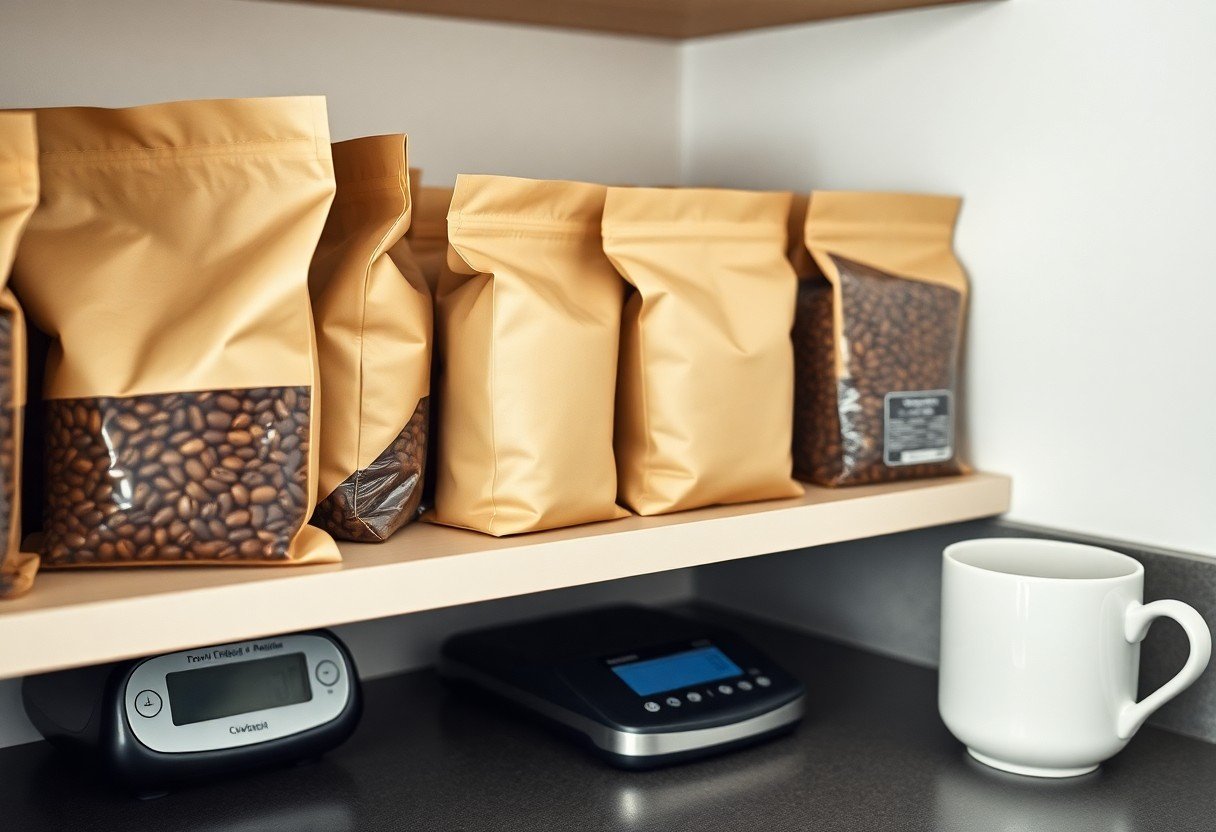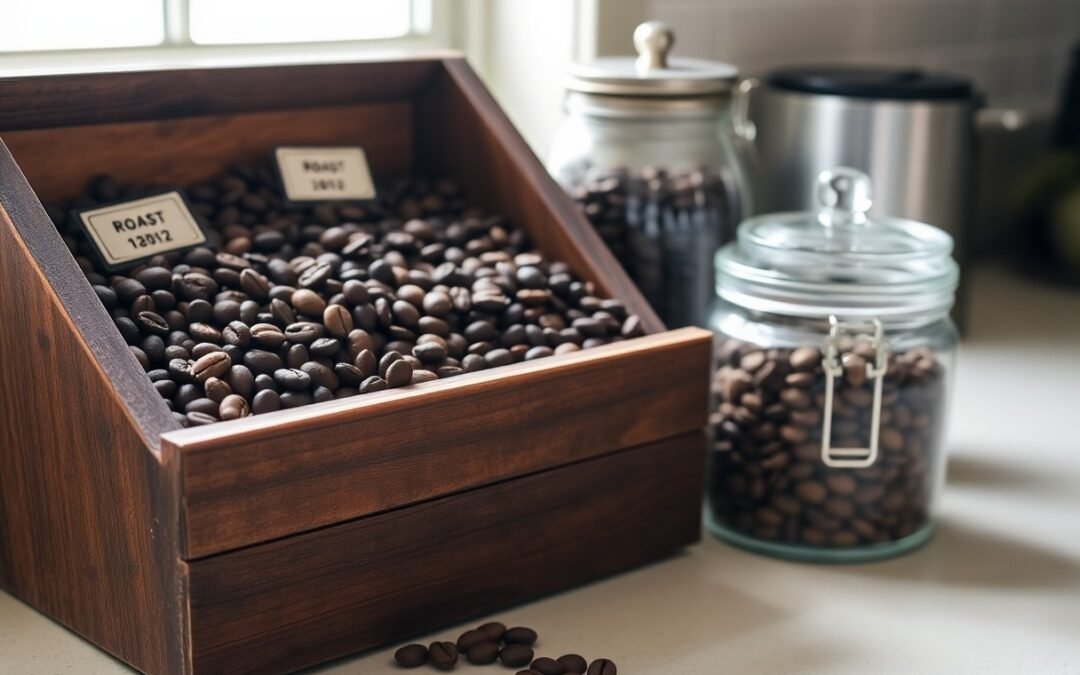Just like any ingredient, how you store your coffee beans can greatly influence their flavor and freshness. Understanding the best practices for coffee bean storage helps ensure that every cup you brew is delicious and aromatic. This post will guide you through the ideal conditions for storing your beans, the shelf life of different types, and tips for maximizing their freshness. By following these recommendations, you can enjoy the rich, robust taste of freshly brewed coffee for longer periods.
The Clock is Ticking: How Freshness Deteriorates
Your coffee beans have a limited lifespan, and as time ticks away, their freshness deteriorates. From the moment they are roasted, chemical changes begin to take place, altering the flavor profile you’ve come to love. Within the first week, your beans are at their peak, but after that, oxygen exposure, moisture, and light start to rob them of their vibrant flavors. By the time three weeks have passed, you may notice a significant decline in taste and aroma, leading to a less enjoyable cup.
The Role of Time in Flavor and Aroma
Distinguishing Between Roasted and Green Beans
Environmental Enemies: Factors That Compromise Freshness
Your coffee beans face several environmental threats that can degrade their freshness over time. Some of the most significant culprits include:
- Temperature
- Humidity
- Light exposure
- Air quality
Perceiving these factors and mitigating their impact is vital for preserving the rich flavors and aromas of your coffee beans.
Temperature Sensitivity: The Heat Factor
Exposure to high temperatures can accelerate the degradation process of your coffee beans. Here’s how varying temperatures can affect their freshness:
Temperature Effects on Coffee Beans
| Temperature | Impact on Freshness |
|---|---|
| Above 70°F (21°C) | Causes oils to evaporate, leading to stale flavors |
| Room Temperature | Acceptable if kept in a dark, cool place |
| Below Freezing | Potential for moisture and flavor loss upon thawing |
Humidity and Its Impact on Bean Integrity
Humidity plays a significant role in the preservation of your coffee beans. Excess moisture can lead to the growth of mold, which compromises quality, while too little can cause beans to dry out too quickly, affecting flavor profile.
Light Exposure: The Silent Bean Killer
Light can be one of the most damaging environmental factors for coffee beans. Ultraviolet rays can cause rapid degradation, leading to significant flavor and aroma loss.
A study by the Coffee Quality Institute shows that even brief exposure to direct sunlight can result in noticeable flavor changes within just a few days. To protect your beans, store them in opaque containers that shield them from light. Dark, sealed environments will help your coffee maintain its rich characteristics longer, allowing you to enjoy every cup to the fullest.
Storage Strategies: Keeping Your Beans at Their Best
Implementing the right storage strategies can extend the life of your coffee beans considerably. By taking simple steps, you can ensure that your beans remain fresh and flavorful for as long as possible. Focusing on the correct containers, ideal storage locations, and advanced techniques like vacuum sealing will help in maintaining the aromatic and taste profiles that make good coffee so enjoyable.
Optimal Containers: Material Matters
Choosing the right container is vital for preserving your coffee beans. Glass, ceramic, and opaque metal are excellent options as they protect against light and air exposure. Avoid clear plastic containers that allow light penetration, which accelerates the degradation process. Select containers with airtight seals, which help keep moisture and oxygen at bay, thus protecting your beans’ integrity for a longer period.
Location, Location, Location: Best Places to Store Beans
Your beans should be kept in a cool, dark place away from direct sunlight, heat sources, and moisture. Ideal locations include a pantry or a cabinet, away from appliances that generate heat, such as ovens and dishwashers. A stable temperature between 60-70°F is preferred since fluctuating temperatures can lead to moisture formation, compromising the essence of your beloved beans.
In addition to temperature, keeping your beans in a consistent environment is crucial. Avoid storing them in areas with high humidity, such as the refrigerator or near the sink, as moisture can cause the beans to develop mold or become stale. A dedicated cabinet or even a drawer can be perfect, allowing easy access while ensuring that your beans maintain their freshness over time.
Vacuum Sealing: A Game-Changer for Longevity
Vacuum sealing offers a revolutionary approach to extending the shelf life of your coffee beans by eliminating exposure to air. This method removes the oxygen that can lead to oxidation and staleness, preserving the beans’ original flavor profile far longer than traditional storage methods.
Utilizing a vacuum sealer not only protects your beans from oxidation but also shields them from moisture and contaminants. By storing your beans in vacuum-sealed bags, you can expect to maintain optimal freshness for several months. Just ensure that you only open the vacuum-sealed package when you’re ready to brew, as repeated exposure to air will shorten their lifespan significantly. This simple technique can be a game-changer for coffee enthusiasts looking to savor their favorite brews without compromise.
Signs You’ve Missed the Mark: Identifying Stale Beans
Stale beans can drastically affect your coffee experience. Knowing the signs can help you determine whether your coffee stash has lost its freshness. Pay close attention to the aroma, flavor, and appearance of your beans. When you learn to distinguish these indicators, you’ll be better equipped to enjoy a delicious cup every time.
Aroma and Flavor Tests: Taste Bud Red Flags
If your beans have lost their vibrancy, you’ll notice a distinct lack of aroma and flavor. Fresh coffee beans should emit a rich, earthy scent. If they smell flat or musty, that’s a clear sign of staleness. The taste will also reflect this – expect dullness, bitterness, or an unpleasant cardboard-like flavor instead of the lively notes you cherish.
Visual Cues: What a Bean’s Appearance Says
The appearance of your beans provides valuable insight into their freshness. Freshly roasted coffee beans will typically have a glossy sheen due to the natural oils present. If the beans look dry, dull, or have an ashy surface, they likely lack freshness. Additionally, check for any odd color changes such as fading or excessive darkening, which can also indicate staleness.
When inspecting the beans, a vibrant, oily sheen is a good sign; it conveys freshness and flavor retention. On the other hand, beans that appear cracked or excessively dry might mean they’ve been exposed to air for too long, leading to loss of vital oils and freshness. If you notice a significant reduction in color vibrancy, the beans are no longer at their prime. Keeping an eye on these visual clues will help you maintain an enjoyable coffee experience by ensuring you’re using the freshest beans possible.

The Freshness Timeline: How Long Can Beans Last?
Your beans’ freshness is ultimately dictated by various factors, including their type and storage method. Generally, roasted coffee beans begin losing their flavor after about two weeks post-roast. It’s possible to extend their lifespan to about a month or more if stored correctly, but the taste will gradually decline. Understanding these timelines helps you prioritize which beans to consume first for the optimal brew experience.
Storage Conditions and Their Duration Impact
The Ideal Freshness Timeline for Different Types of Beans
| Type of Beans | Freshness Duration |
|---|---|
| Light Roast | 2-3 weeks |
| Medium Roast | 2-4 weeks |
| Dark Roast | 1-2 weeks |
| Ground Coffee | 1 week |
| Whole Beans | 1 month |
- Thou should consider consuming light roasts within a few weeks for the best flavor.
| Storage Method | Effect on Freshness |
|---|---|
| Airtight Container | Extends freshness by weeks |
| Vacuum Sealed | Maximizes longevity |
| Open Bags | Causes rapid staleness |
| Cool, Dark Places | Optimal for flavor retention |
| Freezer (if sealed) | Stalls staleness for months |
- Thou must choose the right storage method to enhance your coffee experience.
Final Words
On the whole, understanding the best practices for coffee bean storage can significantly enhance your coffee experience. By keeping your beans in an airtight container away from light, heat, and moisture, you can preserve their freshness for up to two weeks after opening. Opt for whole beans over ground coffee to maximize flavor retention, and purchase in smaller quantities to ensure you enjoy them at their peak. With these tips, you can savor every cup of your beloved brew to the fullest.
Q: How should I store my coffee beans to maintain their freshness?
A: To keep your coffee beans fresh for as long as possible, store them in an airtight container away from light, heat, and moisture. A dark, cool pantry is ideal. Avoid storing beans in the fridge or freezer, as this can introduce moisture when beans are taken in and out. If you need to store beans for an extended period, consider using a vacuum-sealed container.
Q: How long can I keep my coffee beans before they go stale?
A: Generally, whole coffee beans remain fresh for about 2 to 4 weeks after being roasted. If stored properly in an airtight container, they can maintain good flavor and aroma for up to three months. However, for the best taste experience, it’s recommended to use the beans within two weeks of roasting, as the flavor will begin to deteriorate over time.
Q: Can I extend the shelf life of my coffee beans?
A: While coffee beans have a natural shelf life, you can extend their freshness by following certain practices. Using an airtight container, storing them in a cool and dark place, and buying smaller quantities as needed can help. Additionally, some coffee enthusiasts suggest using a nitrogen-flushed bag for storage, which can help keep oxygen at bay and maintain freshness for longer periods.

